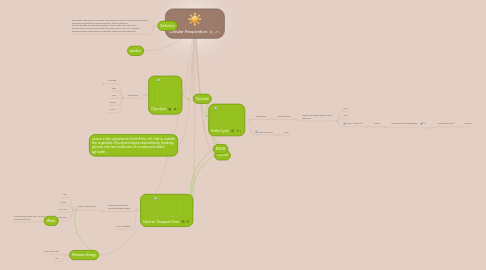Cellular Respiration
by Madison Ross


1. Definition
1.1. The aerobic harvesting of energy from food molecules; the energy-releasing chemical breakdown of food molecules, such as glucose, and the storage of potential energy in a form that cells can use to perform work; involves glycolysis, the citric acid cycle, and oxidative phosphorylation (the electron transport chain and chemismosis).
2. Glycolysis
2.1. Cytoplasm
2.1.1. Glucose
2.1.1.1. Charger
2.1.1.2. Spare Battery
2.1.2. ADP
2.1.3. ATP
2.1.4. NADH
2.1.5. NAD+,
3. Electron Transport Chain
3.1. Mitochondria-where everything takes place
3.1.1. NADH breaks into:
3.1.1.1. FAD
3.1.1.2. NAD+
3.1.1.3. H+ Ions
3.1.1.4. 2 electrons
3.1.1.4.1. The electrons plus the H+ ions plus O2 leads to :
3.2. ATP Synthase
4. Pyruvate
5. Water
6. Releases Energy
6.1. ADP turns into:
6.2. ATP
7. occurs in the cytoplasmic fluid of the cell, that is, outside the organelles. Glycolysis begins respiration by breaking glucose into two molecules of a compound called pyruvate.
8. aerobic
9. FADH2
10. Krebs Cycle
10.1. Cytoplasm
10.1.1. Mitochondria
10.1.1.1. leaves generated during redox reactions
10.1.1.1.1. CO2
10.1.1.1.2. ATP
10.1.1.1.3. NAD+ (turns to)
10.2. ADP turns into:
10.2.1. ATP
